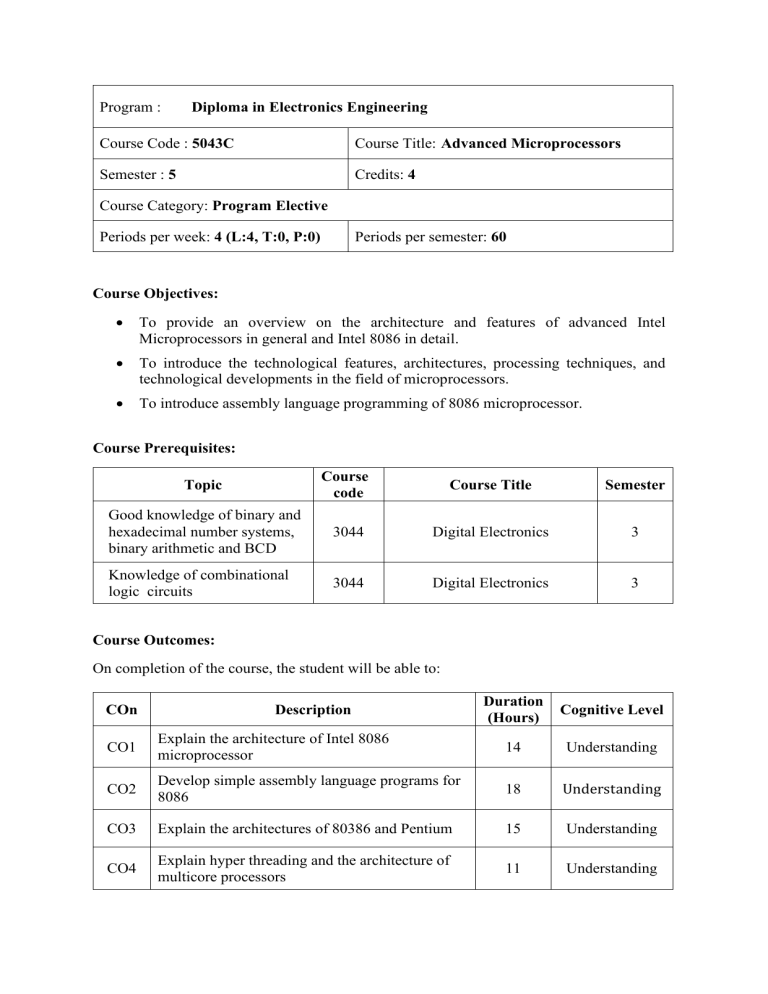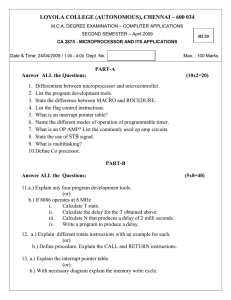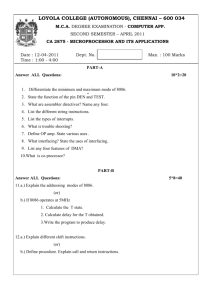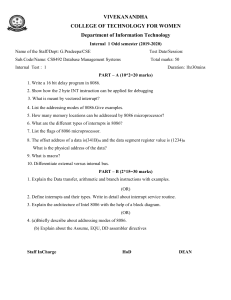
Program : Diploma in Electronics Engineering Course Code : 5043C Course Title: Advanced Microprocessors Semester : 5 Credits: 4 Course Category: Program Elective Periods per week: 4 (L:4, T:0, P:0) Periods per semester: 60 Course Objectives: To provide an overview on the architecture and features of advanced Intel Microprocessors in general and Intel 8086 in detail. To introduce the technological features, architectures, processing techniques, and technological developments in the field of microprocessors. To introduce assembly language programming of 8086 microprocessor. Course Prerequisites: Topic Course code Course Title Semester Good knowledge of binary and hexadecimal number systems, binary arithmetic and BCD 3044 Digital Electronics 3 Knowledge of combinational logic circuits 3044 Digital Electronics 3 Course Outcomes: On completion of the course, the student will be able to: COn Description Duration (Hours) Cognitive Level CO1 Explain the architecture of Intel 8086 microprocessor 14 Understanding CO2 Develop simple assembly language programs for 8086 18 Understanding CO3 Explain the architectures of 80386 and Pentium 15 Understanding CO4 Explain hyper threading and the architecture of multicore processors 11 Understanding Series Test 2 CO-PO Mapping: Course Outcomes PO1 CO1 2 CO2 3 CO3 2 CO4 2 PO2 PO3 PO4 PO5 PO6 PO7 3-Strongly mapped, 2-Moderately mapped, 1-Weakly mapped Course Outline: Module Outcomes Description Duration (Hours) Cognitive Level CO1 Explain the architecture of Intel 8086 microprocessor M1.01 Describe the main features and internal architecture of Intel 8086 4 Understanding M1.02 Explain memory segmentation and physical address generation in Intel 8086 3 Applying M1.03 Illustrate the register set of Intel 8086 2 Understanding M1.04 Explain the pin functions and minimum/maximum mode operations of Intel 8086 5 Understanding Contents: Features of Intel 8086 - Internal architecture of Intel 8086 - Memory segmentation Physical address generation – simple problems - Register set of 8086 - Flag register –Pin diagram - Pin functions - Minimum mode and maximum mode configurations. CO2 Develop simple assembly language programs for 8086 M2.01 Explain interrupt processing in 8086 M2.02 M2.03 M2.04 Interpret the addressing modes of 8086 Outline the instruction set of 8086 Outline the commonly used assembler directives (ASM 86) 4 Understanding 3 Understanding 4 Understanding 3 Understanding M2.05 Make use of the instruction set and assembler directives to develop simple assembly language programs for 8086 4 Series Test I 1 Applying Contents: Sources of interrupts in 8086 - interrupt response - interrupt vector table - types of interrupts - addressing mode - data addressing modes of 8086 - classification of 8086 instructions - instructions of 8086 (outline only) - assembler - assembler directives commonly used assembler directives (ASM 86) - simple assembly language programs. CO3 Explain the architectures of 80386 and Pentium M3.01 Explain the features, internal architecture and operating modes of Intel 80386 5 Understanding M3.02 Illustrate address translation in PVAM 4 Understanding M3.03 Explain the features and internal architecture of Intel Pentium 4 Understanding M3.04 List the operating modes of Pentium 2 Remembering Contents: Key features of Intel 80386 - internal architecture of 80386 - operating modes - address translation in PVAM - segmentation and paging mechanisms - features of Pentium processor - internal architecture of Pentium processor – operating modes CO4 M4.01 M4.02 Explain hyper threading and the architecture of multicore processors Describe the concept of hyper threading technology Identify the limitations of single core processor and the advantages of multicore processor 2 Understanding 1 Understanding M4.03 Explain the concept and major issues of multicore processing 3 Understanding M4.04 Explain the internal architecture of Intel Core2 Duo 3 Understanding M4.05 Outline the technological features of IA processors 2 Understanding Series Test II 1 Contents: Hyper threading technology - define core - limitations of single core processor - concept of multi core processing - advantages - homogeneous and heterogeneous multicore processors - single core and multicore processors comparison - major issues in multicore processing - internal architecture of Intel Core2 Duo (Simple block diagram only) important technological features of IA processors - comparison of Core i3, i5 and i7 processors. Text /Reference: T/R BookTitle/Author T1 Douglas V Hall - Microprocessors and Interfacing - TMH R1 Lyla B Das - The x86 Microprocessors - Second Edition - Pearson R2 R3 Yu Cheng Liu and Glen A Gibson - Microcomputer Systems: The 8086/8088 Family – PHI A NagoorKani - Microprocessor 8086 Programming & Interfacing - RBA Publications. Online resources: Sl. No Website Link 1 https://www.tutorialspoint.com/microprocessor/index.htm 2 https://www.javatpoint.com/8086-microprocessor 3 https://vardhaman.org/wp-content/uploads/2021/03/Unit-1-MPMC.pdf 4 https://electronicsdesk.com/80386-microprocessor.html 5 https://electronicsdesk.com/pentium-microprocessor.html 6 https://www.intel.in/content/www/in/en/gaming/resources/hyperthreading.html 7 https://www.techtarget.com/searchdatacenter/definition/multi-core-processor 8 https://www.javatpoint.com/what-is-a-multicore-processor



